
Dragomir
-
Posts
169 -
Joined
-
Last visited
Content Type
Profiles
Forums
Blogs
Gallery
Events
Store
Posts posted by Dragomir
-
-
Guyana became independent from the UK in 1966, but did not institute her own orders until becoming a Republic in 1970.
The highest order, awarded in a single class, is the Order of Excellence of Guyana. It is awarded to up to 25 living citizens of the Republic for distinction and eminence in any field of endeavour of national or international importance. Foreigners may receive honorary awards.
Badge:
Star:
Gentlemen,
Guyana is not an African country!.
Regards,
Dragomir
0 -
Pour mes amis!
Once mentioned, Dragomir replies> This is the 2nd Class Cross of the Charitable Foundation of St. Andrew the First Called Apostle, founded in London exile during II WW by Yugoslavian Queen Marie (Dowager of Queen Aleksandar I and mother of King Peter II). The Cross was awarded in three classes (1st Class worn from necklet, 2nd Class as pictured, and 3rd Class, which is basically same, only not gilt).
Dragomir
0 -
I agree. I think Bosnians during the Austro-Hungarian Empire period - probably pre-WWI. The fez-shaped hat was very common for men of the time; in fact, it was the shape of the uniform cap for Bosnian soldiers in the KuK Army. Women also covered their heads in this manner. The tri-fold ribbons are, of course, typical of Austro-Hungarian decorations. An old KuK warrior all dressed up with his family for a celebration is my guess.
I agree. I think Bosnians during the Austro-Hungarian Empire period - probably pre-WWI. The fez-shaped hat was very common for men of the time; in fact, it was the shape of the uniform cap for Bosnian soldiers in the KuK Army. Women also covered their heads in this manner. The tri-fold ribbons are, of course, typical of Austro-Hungarian decorations. An old KuK warrior all dressed up with his family for a celebration is my guess.
Sorry, Definitely not Bosniaks. The cap is not sort of fez, it is a fur cap, and the standing man in the back has even more pronounced cap of the similar type. My guess is Serbian or Bulgarian.
0 -
in my opinion it has nothing to do with Russia. The other photo shows two (probably) Georgian women. The first one, however, apparently shows the man with triangularly folded medal ribbons, which is highly unusual for Russia.
Dragomir
0 -
Gentlemen,
Whatever this might be, it is definitely not a Serbian decoration.
Dragomir
0 -
Stars Below sash: Top Uganda Order of Source of Nile. 2nd row Chad Order of National Merit, Burkina Faso Order of Merit [2nd version] 3rd row UNKNOWN Malta Companion of Honour of the National Order of Merit with collar Mauritania National Order of Merit
Unknown is Ukraina's Order of Yaroslav the Wise.
Dragomir
0 -
In fact, the cross appears to be modeled upon St. Mark's Cross of the Orthodox Patriarchate of Alexandria, and in that case, perhaps, initials PP could stand for Pope Peter or Patriarch Peter ( Peter VII, penultimate Patriarch of Alexandria, who perished in helicopter crash). I am not sure that the star has anything to do with the cross (or am I wrong?).
Dragomir
0 -
Interesting... Emmanuel's Order of Civic Merit 'Officer' above is a silver chest decoration with rosette on the ribbon. Elvis has just presented a gold chest decoration with rosette as the '1st Class' - Emmanuel having told us it's a 3-class order, so Commander, Officer, Knight.
Meanwhile Liverpool Medals have 2 items from this order: a gold chest decoration presented as 'officer' and a silver one as 'knight' - neither with rosette... not that you can believe dealers' lists, although LM are better than most.
So what's going on? Most Commander-grades are a neck badge. Is that not the case here?
Well, according to Décret n°147/PR. du 14 août 1963 portant création du « Mérite civique du Tchad », the grade of Commander is a neck badge, with 60 mm diamater.
0 -
Chief of the Order insignia.
Dragomir
 0
0 -
Ups!
The size was to big.
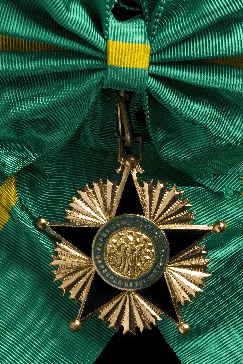 0
0 -
And the accompanying sash badge.
Dragomir
0 -
Emmanuel, Brilliant as always!
May I contribute Order of Merit GC star of another model!
Dragomir
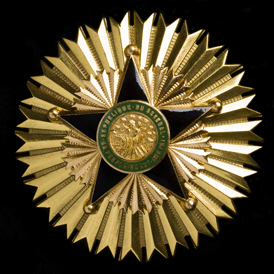 0
0 -
And the fourth, barely recognizable, but might help anyway> The Order of Merit for Arts, Literature and Communications, printed as illustration upon the Order/s Diploma.
Dragomir
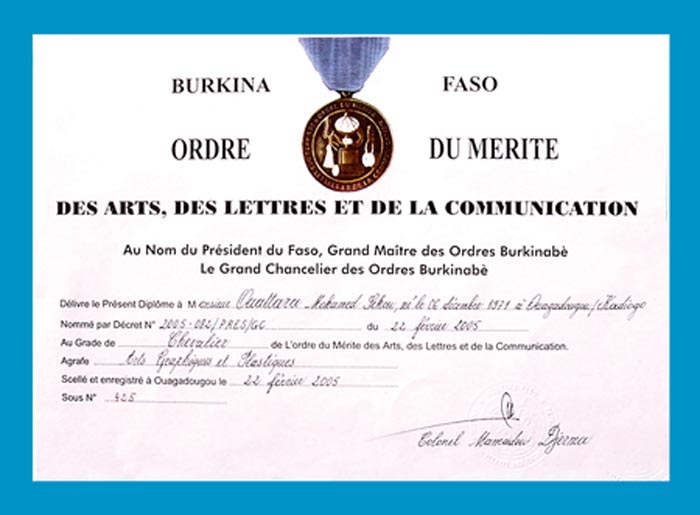 0
0 -
Here comes the third> The Order for Commercial merit.
Dragomir
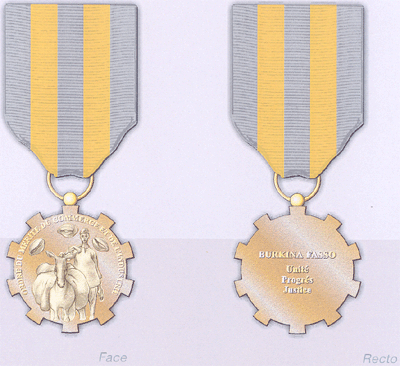 0
0 -
The second Order instituted after the revision of 1993 was the Order of Merit Burkinabe,or Order of Merit.It awarded for reward less higher merit and always in the lower class with a bar on ribbon saying for which kind of merit the Order was attributed.
The Order exist in 5 ranks : Grand Cross,Grand Officer,Commander,Officer & Knight.
We know that at least the follwing casp exist : Amitie-Cooperation (friendship & cooperation) , Education , Action Sociale , Administration , Agriculture et Elevage , Santé (health) , Défense , Sécurité
On the National Day of Burkina Faso in december 2003 : 1 Grand Officer,3 Commander,5 Officer & 152 Knight of the Order of Merit Burkinabe were awarded.
Burkina Faso is one of the few african country who regard his medals as strong national symbol and they give many every year (they not only givve the award document like in some poor country,but they give the medal too).
Here you can see the Order of Merit ; rank of Officer with bar "Amitié-Coopération" awarded to the representant of "Ile de Paix" .It's well known charity organisation that gather money for small projet in Africa.Mostly to make people to get water.
You can see that this person was also awarded a second medal of Burkina Faso : the Medal of Merit of Local Collectivity.
The Medal upon gentleman's breast> Medal of Honour of Local Communities
Dragomir
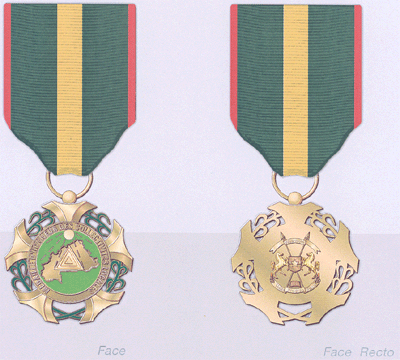 0
0 -
Sorry for the quality.This picture was taken with a non-digital camera in the manufacturer book.It's the onliest I have.
It is Medal of Honour for Water & Forest of Burkina Faso
Again if anyone has a better one.....help is welcome.
Emmanuel
ОК Gentlemen! Emmanuel reigns supreme! I am enjoying every new picture. Let me contribute a little, notwithstanding bad quality of pictures. First, here comes medal of Honour of Firefighters. Three categories> Star of gold, Star of Slver, Star of bronze.
Dragomir
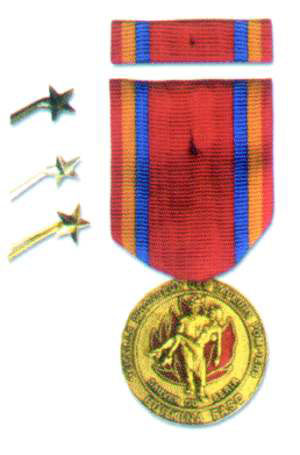 0
0 -
Antonio,
the PDF of the mentioned article would be extremely valuable, as Orden militar de la constancia and all the data regarding it are very elusive.
Best regards,
Dragomir
0 -
(Reverse):

Megan,
You are back! I am relieved and happy.I feared something happened to you.
Yours,
Dragomir
0 -
Hello Bob,
Orders and Medals are in the Museum, but they are not exhibited for the public inspection. In fact, the actual treasure is not within compound of the Museum, and the responsible persons have to request for permission always they need an item for official purposes, but the collection does belong to the Museum and is properly inventoried, documentad and listed. Last time the entire collection was on display in Belgrade is 1980-1981. That was second display ever, the first one being in 1967. At the time of preparation for the 2nd display, I had opportunity to inspect directly all the items and the accompanying documentation. Third display was in Zagreb in 1986. After that, the items were tucked away, but they are still there, except for the GC of the Bath, military group, which was promptly returned to UK. The exhibition room at the Square of Nikola Pasic belongs presently to another Museum (Serbian History Museum). They also have some valuable items in their collection, but the Museum, in fact, has no permanent exhibition space and therefore it's collections are only occasionally displayed at other places.
Yours,
Dragomir
Sorry Gentlemen, I just noticed I missed to add that Denmark's Elephant is also not here. It was returned as per Statutory request.
Dragomir
0 -
Thanks Dragomir. I was in this museum (the mausoleum branch) the day before yesterday, and saw no orders or medals aside from a Tito uniform with miniatures (pics to follow). This morning I went to the branch on Trg Nikole Pasica... but was turned back because the museum was closed (as in, closed down for renovations). Have you actually seen his medals?
Hello Bob,
Orders and Medals are in the Museum, but they are not exhibited for the public inspection. In fact, the actual treasure is not within compound of the Museum, and the responsible persons have to request for permission always they need an item for official purposes, but the collection does belong to the Museum and is properly inventoried, documentad and listed. Last time the entire collection was on display in Belgrade is 1980-1981. That was second display ever, the first one being in 1967. At the time of preparation for the 2nd display, I had opportunity to inspect directly all the items and the accompanying documentation. Third display was in Zagreb in 1986. After that, the items were tucked away, but they are still there, except for the GC of the Bath, military group, which was promptly returned to UK. The exhibition room at the Square of Nikola Pasic belongs presently to another Museum (Serbian History Museum). They also have some valuable items in their collection, but the Museum, in fact, has no permanent exhibition space and therefore it's collections are only occasionally displayed at other places.
Yours,
Dragomir
0 -
I heard a rumor (for what it is worth) that during the NATO bombing Milosjevic moved into the former Tito residence (assuming it would not be bombed) and that his son (Marko) found the orders (and weapons) of Tito in the cellar and took them. Anybody who is friends with the Milosjevic family who can verify?
All of his orders and medals, with exception of the Austro-Hungarian Silver Bravery Medal, are presently in Belgrade, in Museum of History of Yugoslavia. Collar of St. Olav's Order was exhibited in 2009 within a temporary exhibition of twelve strange objects from Tito's treasury that had to do something with notion of death! That was a rather complicated theme, and I would not go into details, but among other items Stalin's gold-and-diamonds saber was also displayed.
Dragomir
0 -
Thank you, Taras - already found that & their pictures of the current Prince Pribina Cross are nowhere as good as the ones you displayed! But I shall try talking to them anyway...
Just keep in mind that they erroneously changed indentification of photos of Orders of Stefanik and Stur.
Regards,
Dragomir
0 -
Not my cup of tea, but thought someone might be interested:
http://cgi.ebay.co.uk/Serbia-Yugoslavia-Orders-and-Decorations-1858-1941_W0QQitemZ250512522033QQcmdZViewItemQQptZUK_Collectables_Militaria_LE?hash=item3a53b5bb31&_trksid=p3286.c0.m14
Sorry, my mistake in previous attempt.
I received my copy yesterday. It is worth any farthing you pay for it. Absolutely fantastic, spectacular and filled to the brim with valuable information: variants, trial pieces, documents, photographs, assay marks, ... Photographs are first class.
All in all, BOOK TO TREASURE!
Dragomir
0 -
Dragomir
Many thanks for the identifications.
As regards palms and torches, palms were awarded for the St George Medal of War, Haile Selassie I Medal of War and the Menelik II Military Medals in Gold or Silver. For the three 1936-1941 Medal of the Campaign (or the Patriot Medal), Medal of the Patriots of the Interior (or the Underground Medal) and Medal of the Patriot Refugees (or the Exile Medal) they were torches, a special local type of reed whose name escapes me, which were tied up in little bundles and used for flaming torches
http://gmic.co.uk/uploads/monthly_09_2009/post-3236-125411810701.jpg.
The picture above shows the difference.
Cheers,
James
Thank you James.
Regarding torches, you are certainly right, only I erroneously considered both things to be palms of different design.
Regards,
Dragomir
1


Croatia “Zagrabia Grünbusch” Breast Star
in Southern European & Balkan States
Posted
This is a carneval decoration.
Dragomir